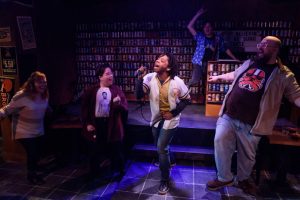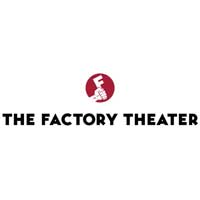
 [rating=3]The Factory Theater’s presentation of “Last Night in Karaoke Town” is an amazing feat of directing by the skillful and inventive Kim Boler. The show is highly spirited and uplifting, filled with singing and dancing. But the feel-good performance, billed as a comedy, sugarcoats a serious and important story that needs to be told about the decline of working-class institutions like neighborhood bars—and what happens when blue-collar work disappears. This is a story not unique to the rustbelt but anywhere in America where good-paying jobs in industry and manufacturing have bit the dust.
[rating=3]The Factory Theater’s presentation of “Last Night in Karaoke Town” is an amazing feat of directing by the skillful and inventive Kim Boler. The show is highly spirited and uplifting, filled with singing and dancing. But the feel-good performance, billed as a comedy, sugarcoats a serious and important story that needs to be told about the decline of working-class institutions like neighborhood bars—and what happens when blue-collar work disappears. This is a story not unique to the rustbelt but anywhere in America where good-paying jobs in industry and manufacturing have bit the dust.
When the audience first enters the theatre, we are immediately wowed by the elaborate set: a complete karaoke bar that has been recreated on a very small storefront stage, down to the finest detail. It is gorgeous and outrageously true to life, thanks to props designer Wyatt Kent, scenic designer Manuel Ortiz, and technical designer Evan Sposato. The audience is seated on bar chairs on risers, complete with tables, and we become immersed as patrons on the sidelines. (Note that because the set takes up so much room, the seats for the audience are relatively few and have been tightly packed together.)
The story is centered around a Cleveland karaoke bar that has been around since 1989. For the past nineteen years, it has been owned by Diana (Wendy Hayne), who took it over when her father passed away. Her bartender for the last four years has been Shannon (Ashley Yates). Shannon and Diana suddenly learn that Ethan Morris (Tommy Bullington) has purchased the building where the establishment is located. Instead of continuing to rent to Diana, the new landlord wants to turn the space into a cider bar (as hard cider is gluten-free has become fashionable among young people). He already owns several upscale restaurants in the city and his aim is to cater to changing tastes. Needless to say, Diana, Shannon, and the regulars are upset that their traditional gathering place will be serving cider instead of beer. But what is more troublesome is that he wants to get rid of the karaoke completely to focus on conversation rather than music. He wants to create a gastropub where the food is more than just pretzels. Ethan is a typecast of the California-loving, gluten-intolerant, and overtly gay man. He is the polar opposite of the presumably gay-intolerant, conservative working-class stiffs who make up the bar’s clientele, who fight to preserve their favorite haunt and, with it, their sentimental reminiscences about their past, separate from whether these were actually happy days or not.
The set is a clever backdrop for Boler’s artistry, with the main part being comprised of three sections: the raised level where the karaoke engineer Kenny (Chase Wheaton-Werle) works the equipment, the middle of the room where the patrons sit at tables, and the bar itself and the bartender. Think about P.T. Barnum’s three rings, where simultaneously performances occur within each. A given ring becomes prominent when the director chooses to emphasize certain characters and aspects of the storyline. Boler’s most brilliant direction occurs, however, when the nexus of action is located in the interstice between one ring and the next and as actors move between rings. Additional credit must go to scene charge artist Maya Jain and sound designers Sarah D. Espinoza and Jonesy Jones, who methodically follow the prominent characters. Microphones are muted and volume is increased or decreased, depending on which activities are currently being focused on. It is rare to see such outstanding stage movement and sound direction in such a confined space. Well done!
Other wonderful elements are the integration of the karaoke and the dancing, in particular when the actors/dancers clean the tables with rags and move all the furniture around to open up the dance floor and then restore the original table and chair configuration. We hear lots of fun music; and of course, the singers have to sing off-key, because that’s what makes the karaoke real. The choreography is great, and the show is very entertaining.
The discussion of a uniquely Cleveland culture is great. It is not just a rivalry with Pittsburgh that makes Clevelanders unique—or the identification with a city’s professional sports team, like the Cavaliers. Rather, it is the native residents’ special way of viewing themselves as a tough lot in a battle for survival against the elements and everything else. This brings to bear an important point: Not only are the distinctive traditions unique to working-class Clevelanders slowly being stripped away, but this is happening everywhere in the face of a growing nationalization and homogenization of American culture: where everybody buys from Amazon, eats at McDonald’s, and shops at Walmart or Target. The question, however, is whether it is necessary to preserve a Clevelander identity in the wake of these major cultural shifts? When is it time to adapt to change, and when should we adhere to the past, and why? Do any of these local traditions have value, and which ones are truly important? Here in Chicago, we can relate. Think of how upset people in Chicago were when Marshall Field’s was sold out to Macy’s. Think about the time when the name Comiskey Park was changed to U.S. Cellular Field; this symbolized the end of an era where the ballpark was named after a Chicagoan, only to be named after a large national corporation and now called Guaranteed Rate Field.
Diana is the only character who truly reveals herself and her motivations for holding onto Karaoke Town and the memories associated with it. But listening to her personal account alone is not sufficient. We hear other voices via several subplots, but these tales are largely too fluffy. To strengthen the plot, most of the characters need to share deeply-felt reasons for keeping things as they are through realistic testimonials—and even some sob stories. The audience needs to comprehend the grittiness of what these people’s lives are like, especially with reference to their previous employment in the factories and steel mills. How did these individuals cope with losing their jobs? What is it about their personal characteristics and their environment that have made so many of them hard drinkers? And why is this particular place so vital to them? We need to witness some very real tensions (such as between Ethan and the rest with regard to his sexual orientation) or else the patrons appear as shells rather than as flesh-and-blood human beings. Above all, the story must replace political correctness with emotional honesty in order to make the characters more memorable and meaningful. Placing more emphasis on the wane of working-class institutions, changing consumer tastes, tolerance (or lack thereof) of alternative lifestyles, and conflicts between the interests of (former) union workers and the owner of a small business would add some measure of gravitas to the story and better balance out its comedic and dramatic aspects.
The raw elements are already present for the making of phenomenal theatre. We are definitely treated to the emotional highs of the music and the lively dance numbers; but as things stand now, the emotional lows are not low enough. A meatier script could transform a mostly saccharine story into a truly great one. The apples are ripe for the picking. The question is whether they will be crushed into hard cider or baked into an old-fashioned apple pie, and who makes this decision and why.
“Last Night in Karaoke Town” is playing through March 28, 2020, at The Factory Theater, 1623 W. Howard Street, Chicago.
Tickets are $10-$25 and may be purchased through the Box Office by calling 866-811-4111 or by visiting TheFactoryTheater.com. 
Performances are:
Fridays and Saturdays – 8:00 p.m.
Sundays – 3:00 p.m.
The Factory Theater is located a 1/2 block east of the Howard Street terminus on the CTA Red Line.
To see what others are saying, visit www.theatreinchicago.com, go to Review Round-Up and click at “Last Night In Karaoke Town”.






More Stories
“Hedda Gabler”
“Clue”
“Ghosts” reviewed by Julia W. Rath